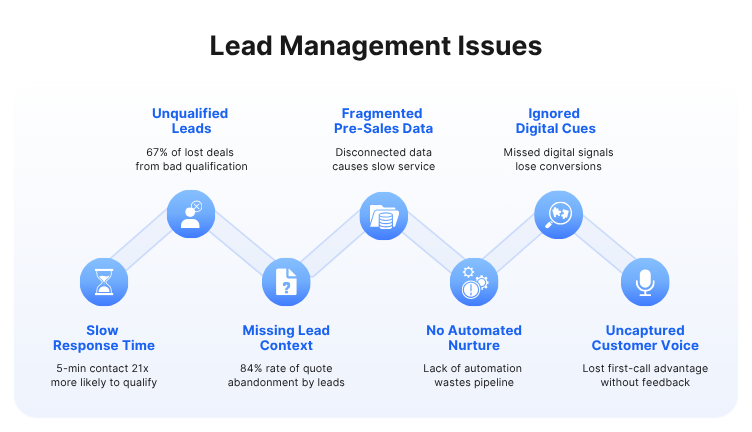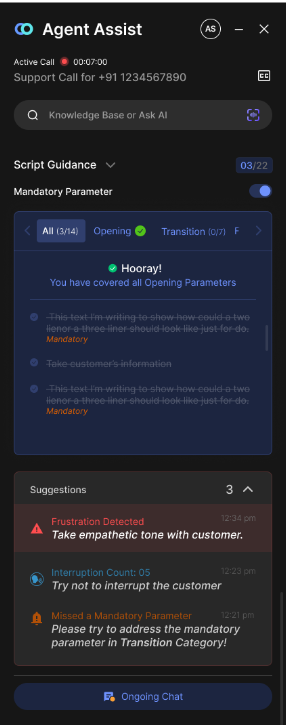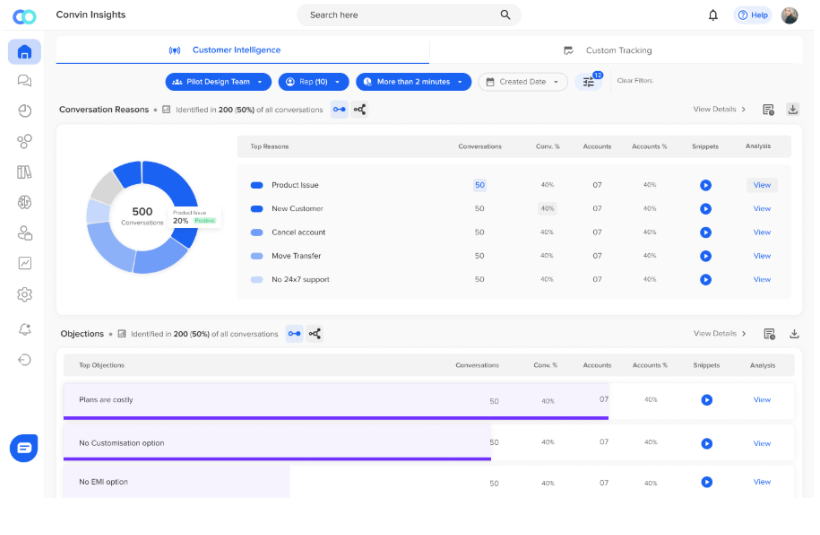Insurance buyers don’t ghost your team on the call, they disappear before it. Research shows that 48% of insurance leads drop off before reaching an agent, often due to delays, disconnected journeys, or incomplete qualification.
These aren’t just missed leads; they’re silent revenue leaks that go untracked, unmeasured, and unresolved.
In this blog, you’ll uncover the 7 critical leaks in your insurance sales funnel, long before your agents even make contact.
We’ll explore where and why drop-offs happen, what data insurers often ignore, and how Generative AI for Insurance, including tools like insurance chatbots, customer service bots, and insurance virtual assistants. helps patch these gaps.
You’ll walk away with a clear, actionable view of what’s breaking your funnel, and what to fix first.
Start fixing hidden funnel leaks, see how Convin powers pre-call engagement.

The 7 Silent Revenue Leaks In Insurance Sales
Every minute that ticks after a prospect signals interest but hears nothing is a micro‑loss. In fact, leads contacted within five minutes are estimated to be up to 21 times more likely to qualify than those left waiting.
Role‑playing on performance reviews won’t fix this; you need to map where the funnel is collapsing before a rep ever picks up the phone. In the next section, we’ll walk through the seven most common drop‑off points in modern insurance sales, and how generative AI for Insurance solves them.
1. Slow Lead Response Times
When a prospect indicates interest, clicks a quote button, completes a form, or chats, you’re entering a race against time. In the insurance industry, the average lead response time stretches beyond 42 hours, yet reaching out within five minutes can increase qualification likelihood by up to 21 times.
Such delays create a window for intent to fade, for alternatives to step in, and for your funnel to leak. When no one responds quickly, the lead silently drifts into competitor territory or simply stops engaging.
Generative AI for Insurance can eliminate this gap by triggering automated conversations the moment interest is shown.
2. Unqualified or Misrouted Leads
Not every lead should be handled the same way. Without a robust qualification and routing framework, you risk sending low‑fit prospects to your premium team or letting hot leads sit idle. Research shows that around 67% of lost deals occur because leads weren’t properly qualified when handed off.
With AI insurance platforms built into your lead system, scoring and routing happen in real time. In an insurance context, this means that your agents spend time only on prospects who are likely to convert. The result is faster connections, lower acquisition cost, and fewer missed opportunities.
3. Missing Lead Context and Intent Signals
A simple web form may capture name, email, phone, but often misses what really matters: intent, pain point, urgency, and channel behaviour.
When agents pick up without this context, the conversation starts behind the curve. Studies show that insurance leads abandon quotes at an astonishing 84% rate, often because the process fails to reflect real intent.
If your system doesn’t capture behavioural cues, pages viewed, dwell time, revisit patterns, you leave the agent blind. Conversational AI insurance tools can surface these buyer signals early and pass them to agents at the right time.
4. Fragmented Pre‑Sales Data Across Channels
Prospects engage across web, mobile, chat, phone, and perhaps an agent referral, and yet many insurers struggle to unify that data into a single view. According to a report, data fragmentation in insurance leads to inefficiencies, slower service, and a bad customer experience.
This fragmentation means that by the time your team picks up the call, they’re working from partial history. Digitalization in insurance has made it possible to centralize these interactions across systems. By integrating CRM, chatbot, and web tools with generative AI for Insurance, you create a seamless handoff for agents.
No more asking for repeated information, no more out-of-sync timelines.
5. No Automated Nurture for Lukewarm Leads
Not every lead is ready to buy right away, but many are worth keeping alive. Without a system to nurture these prospects, you’re leaving money on the table. If you treat every lead like a hot lead, you’ll either waste resources or watch leads go quiet.
An insurance virtual assistant or conversational system can fill that gap: maintain engagement, send timely prompts, capture changing intent, and keep the pipeline warm until an agent becomes appropriate.
6. Ignored Digital Body Language and Early Buyer Signals
Clicks, scrolls, repeats, chat attempts, they’re digital footprints of buyer behaviour. Yet many insurers ignore or misinterpret these early signals. Some research indicates that features like dwell time, repeat visits, and chat engagement correlate strongly with later conversion, but only if captured early.
Ignoring this digital body language means your funnel lacks “early warning” triggers. AI insurance tools embedded within your digital channels allow insurers to respond to these signals in real-time.
7. Failure to Capture Voice of Customer Before Sales
The earliest interactions, chatbots, IVRs, web forms often contain rich sentiment, objections and customer voice data. Yet that insight rarely gets passed to the sales team. In the insurance industry, this means you lose the chance to tailor the first call.
With customer service bots as your front line, capturing VoC early gives your agent a significant head‑start. The absence of this pre‑call insight results in a generic first outreach, lower conversion potential and missed revenue.
Unlock early customer insights with Convin’s VoC intelligence
How Generative AI for Insurance Stops Pre-Call Drop-Offs
If revenue is leaking before a call is made, the fix is upstream, not just additional sales coaching. The industry is investing heavily in digital customer engagement tools, and over 85% of insurers have accelerated digital initiatives since 2020.
This isn’t about replacing agents; it’s about plugging the gaps that occur before contact. Here we’ll explore the key solutions that stop drop‑off early: automated engagement, lead triage, and outreach acceleration, all enabled by generative AI for Insurance.
1. Insurance chatbot and customer service bot for instant engagement
When a lead lands on your website or engages via chat, the clock starts ticking. Every minute of delay dramatically increases the chance the lead will drop off. Research shows that chatbots can handle up to 74.2% of insurance industry conversations automatically
By deploying an insurance chatbot or customer service bot, insurers engage the prospect instantly, ask qualification questions, and capture intent before human contact begins.
With this pre‑agent front line working around the clock, you turn passive visitors into potential conversions.
Instant engagement via bots turns lead arrival into an actionable opportunity, closing the window for silent drop‑offs before your agents ever speak.
2. AI insurance systems for automated qualification and routing
Leads that make it past the first touch often stall next because of poor qualification or routing, the right agent doesn’t get the right lead, or the lead goes cold waiting for routing logic. The 2025 data shows that 65% of insurers are increasing AI investment to fix exactly these kinds of issues.
AI insurance systems bring sophistication: they use conversational data, behavior signals, and integrated profiles to automatically score leads and route them to the best team. That ensures fewer “cold hand‑offs” and more live conversations.
Automated qualification and routing plug one of the most common leaks, leads directed wrongly or left in limbo before a single agent picks up.
3. Digitalization in insurance for seamless data unification
A lead might fill a form, start a chat, and browse content, but if those touchpoints never get stitched together, your agent starts blind. According to recent statistics, by 2025, around 70% of service interactions in insurance will be handled through bots or digital channels.
Digitalization in insurance means integrating web, chat, mobile, CRM, and contact‑center data into a cohesive customer profile. When your agent gets the hand‑off, they know the path the prospect has already walked, enabling a relevant, timely conversation.
Unifying pre‑sales data means no more fragmented journeys; the agent begins where the buyer is, not where you hope they are.
Unify pre-sales data flows with AI-driven insurance systems
This blog is just the start.
Unlock the power of Convin’s AI with a live demo.

Conversational AI Insurance: Capturing Buyer Intent Early
When a prospect visits your site or interacts via chat, they leave digital footprints, scroll depth, repeat visits, and hesitation. Most insurers treat these like optional data points, but they’re critical.
The difference between acting on those signals and missing them can be the difference between a win and a silent loss. In this section, we’ll cover how you can convert behavioral cues into pipeline momentum.
1. Insurance virtual assistant for long‑tail engagement
Not every lead is ready to convert instantly. Many require follow‑up, nurture, and timely check‑ins. An insurance virtual assistant fills that gap. By maintaining ongoing engagement, reminders, micro‑questions, and content nudges, the assistant keeps your funnel alive until the prospect is ready.
Convin data shows insurers using ongoing automation see major improvements in pipeline throughput and fewer “silent losses.”
The virtual assistant prevents lukewarm leads from slipping away by nurturing them until they’re ready for an agent call.
2. Conversational AI insurance to detect high‑intent behavior
Behavior reveals intention. Scrolls, repeat visits, paused chats, and question patterns all hint at readiness or hesitation. Conversational AI insurance tools interpret these signals in real time.
For example, they capture when a visitor lingers on a premium‑increase page and trigger a follow‑up, not hours later but immediately. One industry report showed that automation of support and interactions cut handling times by as much as 80%. convin.ai
Recognising buyer intent early transforms passive data into proactive action, giving you a distinct edge before competitors even engage.
3. Customer service bot as the first source of Voice of Customer
Bots handle thousands of conversations before a human touches them. In that volume lies insight: objections, concerns, language patterns, sentiment.
Yet many organizations discard that insight. Using a customer service bot as your first “voice of customer” channel captures this goldmine. Convin found that automation in feedback and voice capture reduced operational cost by up to 65% in specific workflows.
Capturing VoC at the earliest stage arms your sales and retention teams with real customer language, before anyone calls or meets the prospect.
Capture VoC early with Convin’s AI-enhanced service bot
Convin in Action: Closing Gaps with Generative AI for Insurance
Concepts matter. But execution matters more. For VPs of Sales or RevOps, the key question is: “Does this work in our world of KPI pressure, regulation, and channel complexity?” It must.
That’s where sanitized proof points and case examples of a unified AI stack make a difference. Next up, we break down how Convin’s suite closes pre‑call gaps with measurable lift.

Alt: real-time agent assist to close leads while on call
1. Real‑time agent assist that turns insights into revenue
Your agents are the final step in this chain, but without context, they face long odds. Real‑time agent assist overlays the pre‑call data: conversation history, sentiments, objections, and suggested next actions.
For example, Convin’s tools fully audit 100% of conversations, feeding live prompts and performance guidance.
When the agent starts with full context, not just a number on a screen, they convert more leads and reduce wasted calls.

2. Contact center intelligence that uncovers hidden friction
Contact center intelligence systems monitor every pre‑sales touchpoint, chat bot logs, voice transcripts, email threads, and surface patterns of friction. Maybe every third lead drops off after a particular form field or chat question. These insights allow RevOps to fix the funnel itself.
As highlighted by Convin, consistent monitoring and automation lead to measurable reductions in errors and faster cycle times.
Hidden bottlenecks become visible when you treat the contact center as a strategic funnel sensor, not just a cost center.
3. Voice of customer software that drives smarter outreach
The final lever in closing pre‑call revenue gaps is understanding what the customer really wants, and when. Voice of customer software analyses tone, themes, sentiment and surfacing what matters most: timing, motivated needs, language. This turns outreach from generic to relevant.
Insight‑driven outreach means fewer ignored calls, fewer dropped leads, and higher conversion from the very start.
Explore Convin’s Voice of Customer software for smarter insurer outreach
Final Word: Patch Revenue Leaks with Generative AI for Insurance
The most expensive revenue loss in insurance sales isn’t what agents say, it’s the conversations that never happen. From missed follow-ups and misrouted leads to overlooked buyer signals and fragmented data, these pre-call drop-offs are easy to ignore but costly to overlook.
That’s where Generative AI for Insurance offers a decisive edge, bridging the gaps with intelligent engagement, qualification, and context-rich handoffs.
For teams looking to take control of these leaks, Convin brings it all together. With real-time agent assist, conversational intelligence, and Voice of Customer software under one stack, insurers gain full visibility into the sales journey, before and after the first contact. Want to see what your team is missing?
Book your Convin AI demo today!
FAQ
1. What is the biggest threat to the insurance industry at the moment?
The biggest threat is revenue leakage from fragmented customer engagement, leads drop off before agents respond, data silos block visibility, and intent signals go unnoticed. This silent churn costs insurers millions annually. Platforms using Generative AI for Insurance, like Convin, help plug these gaps with pre-call automation, voice of customer insights, and real-time agent support.
2. What are the insurance tech trends in 2025?
Key insurance tech trends for 2025 include:
- Real-time AI-powered lead routing
- Voice of Customer analytics for personalization
- Full-funnel automation using generative AI for Insurance
- Intelligent virtual assistants for claims and sales
- Omnichannel data unification for RevOps
Convin leads in several of these areas with its AI-enabled contact center and agent-assist tools.
3. Will AI replace insurance brokers?
No, but AI is redefining its role. Rather than replacing brokers, solutions like generative AI for Insurance enhance them by automating pre-call engagement, surfacing buyer insights, and streamlining service workflows. Tools like Convin allow brokers to focus on high-value conversations, not repetitive tasks.
4. What is the broking channel in insurance?
The broking channel refers to the network of licensed intermediaries, insurance brokers, who connect insurers with potential customers. They advise, negotiate, and customize coverage. In 2025, generative AI for Insurance is augmenting this channel with smarter insights and faster lead handling. Convin helps brokers close more deals by equipping them with real-time context and performance guidance.








.avif)